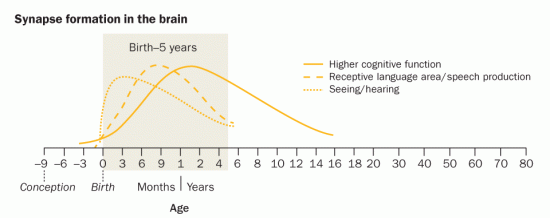
Different functions in the brain, such as thinking and seeing, develop during varying time windows, as nerve cells form new connections called synapses. Though scientists used to think such development had clear peaks and then waned with age (image), evidence now suggests substantial flexibility can be restored in adulthood.
Research aimed at restoring the brain’s youthful flexibility is leading to a more nuanced view of findings from the 1960s. In experiments that won them the Nobel Prize in physiology or medicine, David Hubel and Torsten Wiesel discovered that sealing shut a kitten’s eye for a period during the early stage of life would leave the animal unable to see normally out of that eye. If the opposite eye were then patched, forcing the underdeveloped eye to work, the kitten could recover, scientists later discovered. This patch fix worked only on a young animal, suggesting there was a finite window of time during which the brain could rewire itself.
Humans have this window of opportunity too. During what scientists call a “critical period,” nerve cells in the brain can forge new connections, sprouting tendrils that carry messages to other cells. Children with amblyopia, a condition in which one eye is weaker than the other, can be cured with a patch over the strong eye, which forces the brain to rewire incoming information from the stunted eye. In adulthood, the exact same treatment is useless. By figuring out why this period ends, and why other forms of flexibility are also lost, researchers think they might be able to bring the brain’s healing power back.
A malleable brain, researchers hope, can heal after a stroke, combat the decline in vision that comes with old age and perhaps even repair a severed spinal cord. An end to childhood — and the prodigal learning that comes with it — does not need to eliminate the brain’s capacity for change. “There are still windows of opportunity out there,” says neuroscientist Daphné Bavelier of the University of Rochester in New York. “It may require a little more work to open them, though.”
Reference: Sanders, L. The Brain Set Free. Science News. August 11th, 2012; Vol.182 #3.
